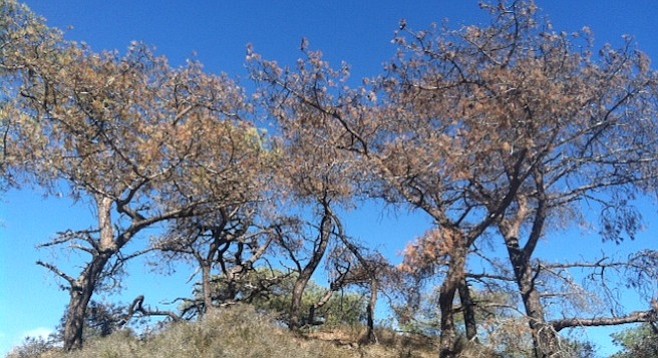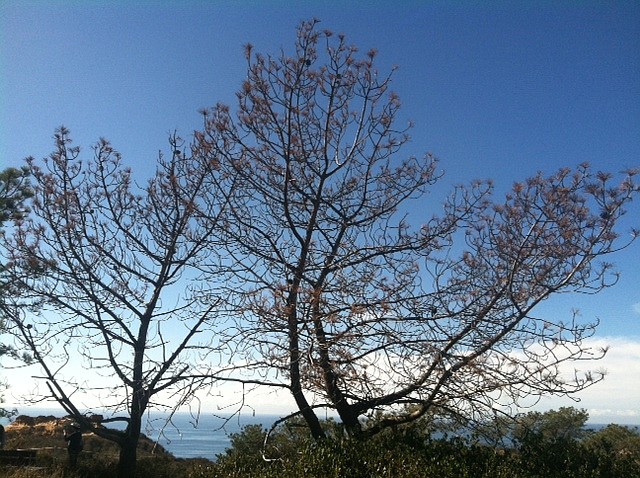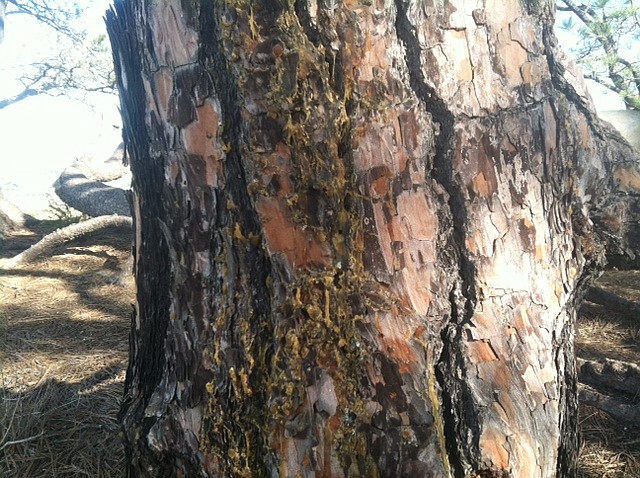 Facebook
Facebook
 X
X
 Instagram
Instagram
 TikTok
TikTok
 Youtube
Youtube

Pinus torreyana (aka Torrey pines) are among the rarest pine trees in the world. They occur naturally only on Santa Rosa Island (west of Ventura) and here in San Diego at Torrey Pines State Natural Reserve.
At Torrey Pines State Reserve there are currently less than 4600 of the pine trees growing. They are protected by state law and monitored by state-employed scientists and park staff. Park volunteers and visitors also keep an eye out for anything amiss in the park.

In the late 1980s and early ‘90s, because of a three-year drought and a severe wind storm, the park experienced a die-off of Torrey pines due to attacks by the California five-spined engraver beetle and the red turpentine beetle. About 12 percent of the total population of pines in the park — 850 trees — succumbed to bark-beetle attacks.
Since that time, state biologists have used pheromone traps to monitor bark-beetle populations. By monitoring the rise and fall of these naturally occurring bark-beetle populations, it can be determined if actions need to be taken to protect the pines.
When the pines are stressed, by drought or or other factors, they are less able to ward off attacks by the beetles. The current drought and higher temperatures have been especially hard on the trees. Park staff have identified about 100 trees that are dead or dying from beetle infestation at this time. These trees cannot be saved. In order to reduce the infestation and protect healthy trees, the affected trees will be removed.

Trees infected by bark beetles have hundreds of small holes that weep sap all over them. Their canopies then turn brown and the tree dies. Several trees at High Point Vista and the grove behind the Torrey Pines Lodge are slated for removal. It is hoped that this quick, definitive response to the problem (along with a better-than-average rainy season) will stop the spread of the beetle infestation and revitalize the Torrey pine population.


Pinus torreyana (aka Torrey pines) are among the rarest pine trees in the world. They occur naturally only on Santa Rosa Island (west of Ventura) and here in San Diego at Torrey Pines State Natural Reserve.
At Torrey Pines State Reserve there are currently less than 4600 of the pine trees growing. They are protected by state law and monitored by state-employed scientists and park staff. Park volunteers and visitors also keep an eye out for anything amiss in the park.

In the late 1980s and early ‘90s, because of a three-year drought and a severe wind storm, the park experienced a die-off of Torrey pines due to attacks by the California five-spined engraver beetle and the red turpentine beetle. About 12 percent of the total population of pines in the park — 850 trees — succumbed to bark-beetle attacks.
Since that time, state biologists have used pheromone traps to monitor bark-beetle populations. By monitoring the rise and fall of these naturally occurring bark-beetle populations, it can be determined if actions need to be taken to protect the pines.
When the pines are stressed, by drought or or other factors, they are less able to ward off attacks by the beetles. The current drought and higher temperatures have been especially hard on the trees. Park staff have identified about 100 trees that are dead or dying from beetle infestation at this time. These trees cannot be saved. In order to reduce the infestation and protect healthy trees, the affected trees will be removed.

Trees infected by bark beetles have hundreds of small holes that weep sap all over them. Their canopies then turn brown and the tree dies. Several trees at High Point Vista and the grove behind the Torrey Pines Lodge are slated for removal. It is hoped that this quick, definitive response to the problem (along with a better-than-average rainy season) will stop the spread of the beetle infestation and revitalize the Torrey pine population.
Comments